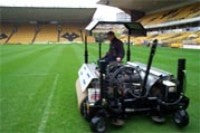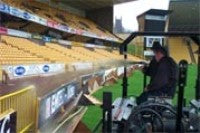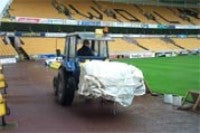Watery Wolves
Watery Wolves
 By John Calderwood
By John Calderwood
When we left the ground on Friday, the home game against Walsall was five days away and the pitch seemed to be holding up quite well with the recent rain that we had encountered. By Sunday, I was a worried man, it never stopped raining all day and for the most part it was heavy rain.
As I got back in to work early on Monday, with the rain still beating down, my first call was to hire 'The Blotter', (a motorised sponge is probably the best way to describe it). It is a tool that we used at Wembley with great effect and I hired it in November, here at Molineux, to get the local derby game against West Bromwich on- a game saved by the Blotter's performance.
We have an old set of McCloud rain covers here and we set these out around the ground on the tarmac in readiness, using our tractor-mounted forks.
The Blotter arrived at about 11:30 and I got it working straight away on the surface water that was now lying across large areas of the pitch.

Hopefully after the heavy rain predicted tonight, there will be a strong wind and some sunshine tomorrow. We will be able to get the covers off in the morning, prepare the pitch for the game and then use the Blotter to remove any further surface water that may come with the rain. The beauty of having this type of machine is that it can be used right up to the kick off, even at half time!
So far this season there have been 24 games. The first, reserve and youth teams all use the pitch and we have had three full training sessions and about 6 one hour sessions as well. The first team are playing some exceptional football at the moment so it is imperative that we maintain a first class surface for them, but all this rain is starting to make the pitch heavy in areas.
The pitch has poor drainage and the last major work done on it was in 1992 when the stadium was being reconstructed. At the time the pitch was moved over by almost half a pitch and the 'new' half is by far and away the best side in front of the John Ireland stand.
The club are currently deciding on the full reconstruction of the pitch and hopefully the prospect of Premier football will sway their decision favourably. The pitch causes constant headaches as it has drainage inconsistencies all over it. In the winter there are areas that become heavy and boggy, and in the summer there are areas that drink water for fun, dry very quickly and then suffer heat stress and become vulnerable to fungal disease.

I have had the pitch Vertidrained twice this season so far going only to a depth of 150mm(the maximum depth I can safely go) using 12 mm tines on a 100mm x 100mm pattern. Last week in anticipation of this weeks games and the inclement weather I used the vertidrain with needle tines. This produced a much tighter pattern and although the tines aren't as thick, there are thousands more holes created in the ground.
We also have a Ryan GA30 here and I use this machine at least monthly to keep the surface open here and at the training ground. The Ryan goes in to 100mm using 12mm tines on a 50mm x 50mm pattern.
The aeration of the ground is very important, to help with drainage, but also to encourage more air into the root zone. The more air space in the root zone the healthier the roots and therefore the plants.


